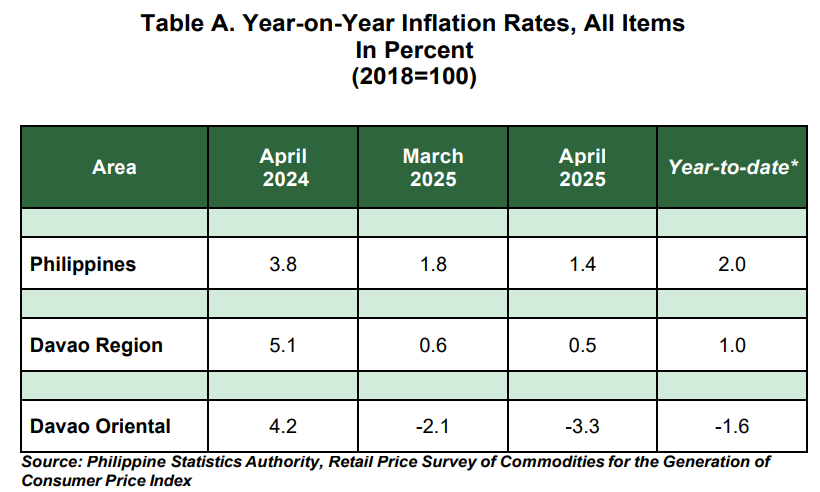
The inflation rate in Davao Oriental experienced a further decline, decreasing to -3.3 percent in April 2025, down from -2.1 percent in March. This reduction results in an average inflation rate of -1.6 percent for the province from January to April 2025. For comparison, the inflation rate in April 2024 was higher at 4.2 percent. (as shown in Tables A and B, and Figure 1)
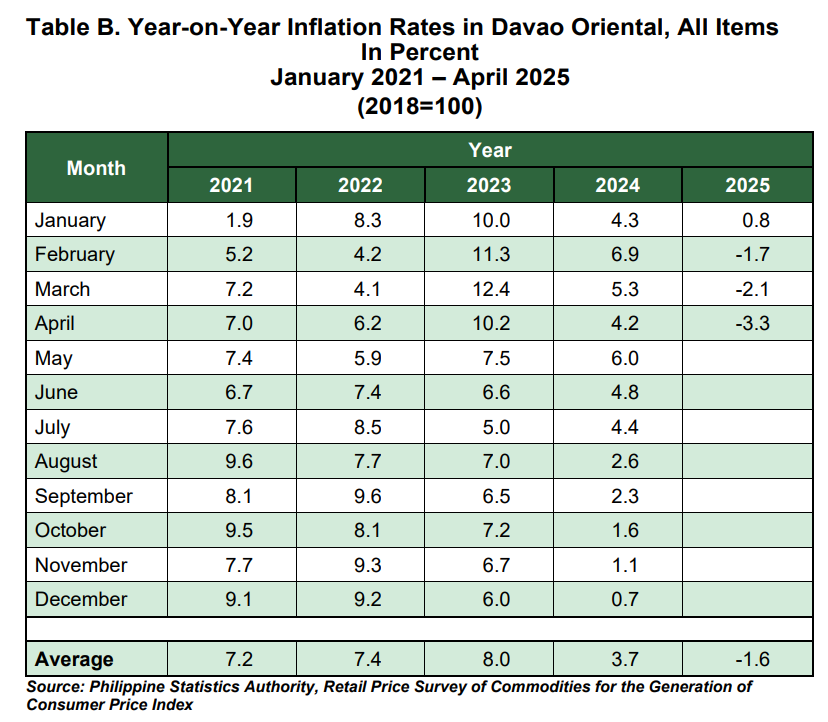
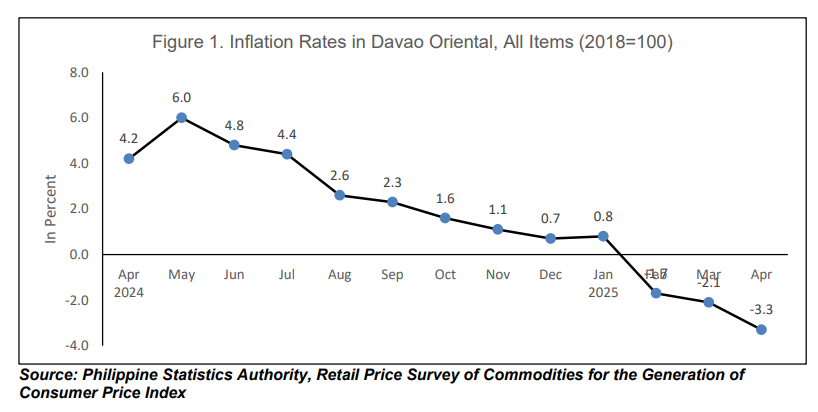
The downtrend in overall inflation in April 2025 was primarily influenced by the faster annual decline in the index of food and non-alcoholic beverages, which was -5.9 percent in April 2025 from -3.6 percent of the previous month. Another contributor to the downtrend was transport, which recorded a faster annual decline of -8.6 percent during the month from -6.2 percent in the previous month.
Moreover, an increase in annual increments were noted in the indices of the following commodity groups during the month:
a. Alcoholic Beverages and Tobacco, 2.0 percent from 1.6 percent;
b. Housing, Water, Electricity, Gas, and Other Fuels, 1.0 percent from -0.2 percent;
c. Personal Care, and Miscellaneous Goods and Services, 2.8 percent from 2.5 percent; and
d. Clothing and Footwear, 2.8 percent from 2.7 percent
Meanwhile, the indices of the rest of the commodity groups retained their respective previous month’s annual rates. (as shown in Table C)
At the provincial level, food inflation eased to -6.5 percent in April 2025 from -4.0 percent in the previous month. In April 2024, food inflation was higher at 5.5 percent. (as shown in Table D)
The deceleration of food inflation in April 2025 was primarily brought about by the slower inflation rate of Fish and other Seafood at -13.1 percent during the month from -5.6 percent in March 2025. This was followed by the faster year-on-year decline of Rice at -16.5 percent during the month from -12.4 percent in March 2025.
In addition, lower inflation rates during the month were noted in the indices of the following food items:
a. Sugar, Confectionery and Desserts, 5.8 percent from 9.0 percent;
b. Cereals (ND), -17.3 percent from -14.9 percent;
c. Vegetables, tubers, plantains, cooking bananas and pulses, 0.5 percent from 1.5 percent;
d. Oils and Fats, 0.6 percent from 1.0 percent;
e. Flour, Bread and Other Bakery Products, Pasta, and Other Cereals, 0.6 percent from 0.8 percent; and
f. Meat and other parts of slaughtered land animals, 7.1 percent from 7.2 percent
In contrast higher annual increments were noted in the indices of the following food groups during the month:
a. Corn, -20.3 percent from -24.2 percent;
b. Fruits and Nuts, 5.6 percent from 4.3 percent;
c. Ready-made food and other food products N.E.C, 3.7 percent from 3. 2 percent; and
d. Milk, other dairy products and eggs, 3.5 percent from 3.3 percent. (as shown in Table D)

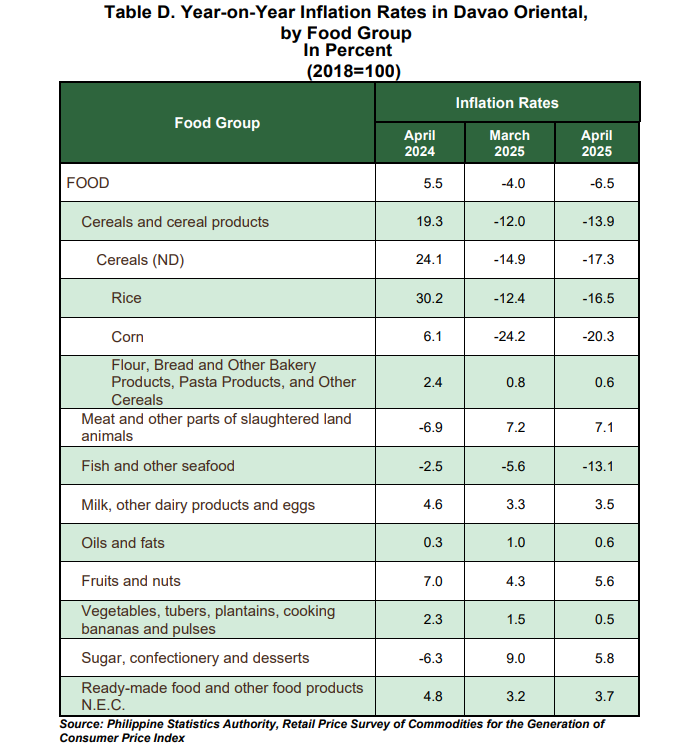
In April 2025, a mixed inflation trend was observed across all provinces and the highly urbanized city in the Davao Region, compared to March 2025. Davao Oriental, Davao de Oro, Davao Occidental, and Davao del Norte recorded lower inflation rates, while the City of Davao maintained the same rate as the previous month. Conversely, Davao del Sur experienced a slight increase in its inflation rate. Davao Oriental reported the lowest inflation rate at -3.3 percent, whereas Davao City had the highest rate at 1.9 percent. (as shown in Table E)
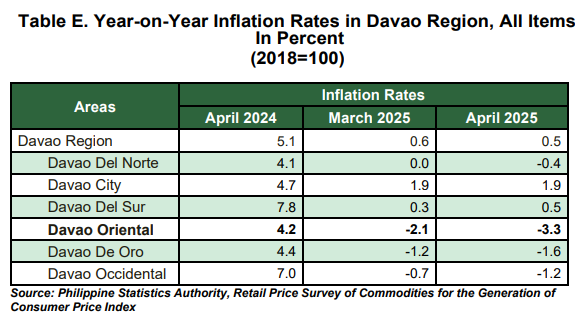
Purchasing Power of the Peso (PPP)
The purchasing power of the peso (PPP) shows how much the peso in the base year (2018) is worth in another period. It is computed by getting the reciprocal of the CPI and multiplying the result by 100.
As of April 2025, the purchasing power of the peso (PPP) in Davao Oriental increased to 0.79, indicating that PhP1.00 in 2018 is now equivalent to PhP0.79. The PPP was higher than in April 2024 at 0.76. (as shown in Figure 2)
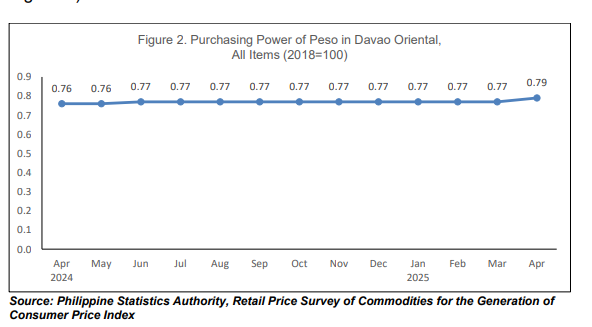
TECHNICAL NOTES
Uses of CPI
The CPI is most widely used in the calculation of the inflation rate and purchasing power of peso. It is a major statistical series used for economic analysis and as a monitoring indicator of government economic policy.
Computation of CPI
The computation of the CPI involves consideration of the following important points:
a. Base Year/Period - A period, usually a year, at which the index number is set to 100. It is the reference point of the index number series.
b. Market Basket - A sample of the thousands of varieties of goods purchased for consumption and services availed by the households in the country selected to represent the composite price behavior of all goods and services purchased by consumers.
c. Weighting System - The weighting pattern uses the expenditures on various consumer items purchased by households as a proportion to total expenditure.
d. Formula - The formula used in computing the CPI is the weighted arithmetic mean of price relatives, the Laspeyre’s formula with a fixed base year period (2006) weights.
e. Geographic Coverage - CPI values are computed at the national, regional, and provincial levels, and for selected cities.
Note: CPIs and inflation rates by province and selected city are posted at the PSA website (https://openstat.psa.gov.ph/).
Approved for release:
EMILY P. TOMOGDAN
Chief Statistical Specialist
